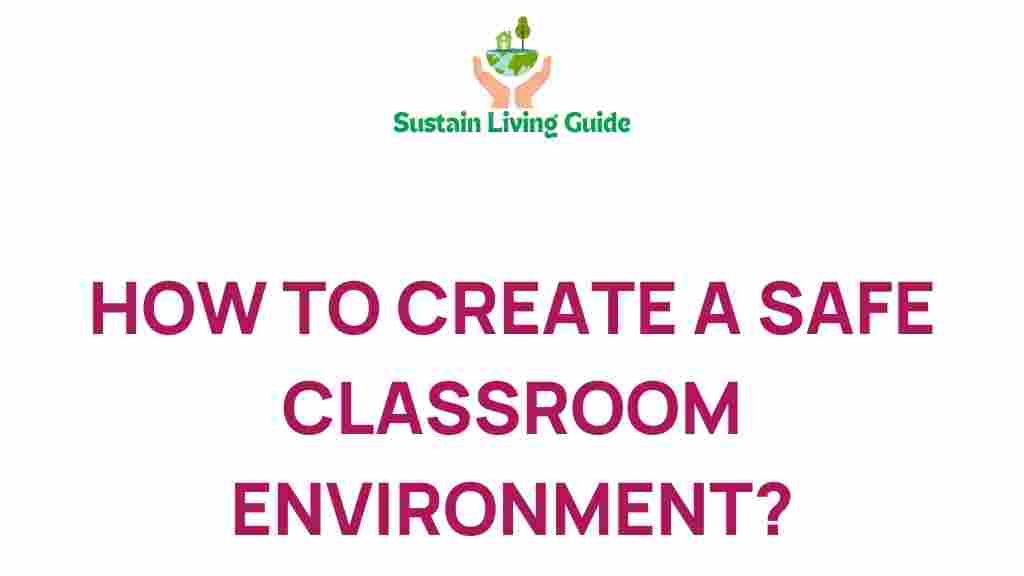Unlocking the Secrets to a Safe Classroom Environment
Creating a safe classroom environment is crucial for fostering learning, growth, and emotional well-being among students. The classroom should be a sanctuary where students feel protected, respected, and encouraged to express themselves. In this article, we will explore essential strategies and practices that educators can implement to ensure a safe classroom. From physical safety measures to emotional support, we will cover all aspects of creating a nurturing educational space.
Understanding the Importance of a Safe Classroom
A safe classroom is not just about physical safety; it encompasses emotional and social aspects as well. Here are some reasons why a safe classroom is vital:
- Enhanced Learning: Students learn better when they feel safe and secure.
- Emotional Well-being: A supportive environment helps students manage stress and anxiety.
- Positive Behavior: A safe classroom promotes respect and reduces bullying.
- Effective Communication: Students are more likely to participate when they feel safe.
Step-by-Step Process to Create a Safe Classroom
Creating a safe classroom involves a multi-faceted approach. Here’s a step-by-step guide that educators can follow:
Step 1: Assess the Physical Environment
The first step in establishing a safe classroom is to ensure the physical surroundings are secure. Consider the following:
- Check for any hazardous materials or objects that could cause harm to students.
- Ensure that exits are clearly marked and accessible in case of emergencies.
- Maintain a clean and organized space to prevent accidents.
- Implement safety protocols for technology and equipment.
Step 2: Establish Clear Rules and Expectations
Setting clear rules and expectations helps students understand what is acceptable behavior within the safe classroom. Here’s how to do it:
- Involve students in creating classroom rules to foster ownership.
- Display rules prominently in the classroom.
- Consistently enforce the rules to maintain order and respect.
Step 3: Foster Positive Relationships
Developing strong relationships between educators and students is fundamental in a safe classroom. Consider these strategies:
- Show genuine interest in students’ lives and listen to their concerns.
- Encourage collaborative activities that promote teamwork.
- Provide opportunities for students to express their feelings and thoughts.
Step 4: Implement Social-Emotional Learning (SEL)
Integrating SEL into the curriculum can significantly enhance classroom safety. Here are some ways to do this:
- Teach students skills for managing emotions and setting goals.
- Encourage empathy and understanding through group discussions.
- Provide resources for students who may be struggling with emotional issues.
Step 5: Prepare for Emergencies
A crucial aspect of a safe classroom is being prepared for emergencies. This includes:
- Conducting regular emergency drills (fire, lockdown, earthquake).
- Creating an emergency response plan that includes students and staff.
- Keeping first-aid supplies readily available and accessible.
Troubleshooting Tips for Maintaining a Safe Classroom
1. Addressing Bullying
If bullying is observed or reported:
- Take immediate action to address the behavior.
- Provide a safe space for the victim to discuss their feelings.
- Engage in conflict resolution discussions with both parties involved.
2. Managing Classroom Disruptions
For disruptive behavior:
- Identify the underlying cause of the behavior.
- Use positive reinforcement to encourage good behavior.
- Implement a behavior management plan tailored to the student’s needs.
3. Supporting Students with Special Needs
Ensure that all students, including those with special needs, feel safe:
- Provide necessary accommodations based on individual needs.
- Involve special education professionals when needed.
- Be patient and flexible in your teaching approach.
Utilizing Resources for a Safe Classroom
There are numerous resources available for educators looking to enhance their safe classroom practices. Consider the following:
- National Center for Safe Supportive Learning Environments – Offers tools and resources for creating safe educational spaces.
- Safe Schools Coalition – Provides information and support for fostering safe classrooms for all students.
Conclusion
In conclusion, unlocking the secrets to a safe classroom environment requires dedication, awareness, and a proactive approach. By assessing the physical environment, establishing clear rules, fostering positive relationships, implementing social-emotional learning, and preparing for emergencies, educators can create a space where students feel secure and valued. Remember that maintaining a safe classroom is an ongoing process that may require adjustments and continuous learning. With the right strategies in place, we can ensure that every student has the opportunity to thrive in a safe and supportive atmosphere.
This article is in the category Education and created by SustainLivingGuide Team
